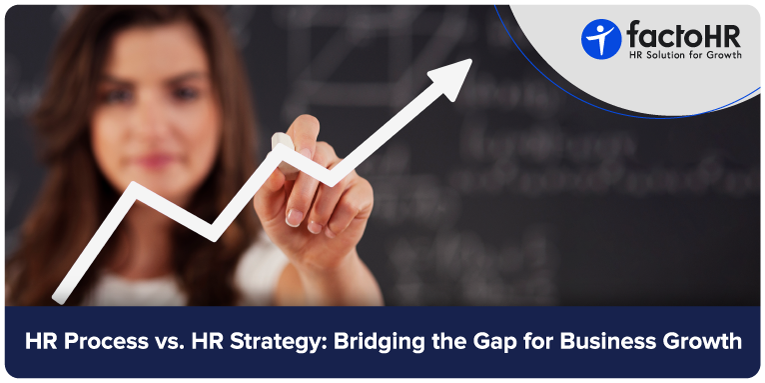HR Process vs HR Strategy: Key Differences Explained

Table of Contents
Executives, CEOs, and HR managers often find themselves at a loss, wondering why some organizations seem to have a nearly infinite talent pool. How do some organizations outperform their competitors despite having almost similar resources? Their success may be due to their understanding of the difference between HR processes and HR strategy, and their ability to adjust their human resources to suit their business needs.
Brands like Google, Apple, Microsoft, and Amazon match their HR processes with their HR strategy. This helps them manage performance, hire top talent, and engage employees, while also improving productivity.
The HR process is an operational process that encompasses various HR activities, including recruitment, onboarding, and performance evaluation. In contrast, an HR strategy is a strategic process that aligns human resources with the long-term needs of the organization.
Let’s understand the difference between HR process and HR strategy and learn about how to synchronize the HR process and strategy.

HR Process vs HR Strategy: What’s the Real Difference?
The HR process encompasses a set of activities that include everyday HR operations, such as recruitment, onboarding, performance appraisal, and payroll management.
On the other hand, HR strategy is a plan that aligns human capital with business outcomes.
The HR process is a tactical approach that primarily addresses the current needs of an organization. Meanwhile, HR strategy responds to both current and future challenges.
HR processes are reactive in nature, as they deal with current requirements. However, HR strategies are more proactive, as they help prevent potential issues. For example, hiring candidates to address current necessities can be considered an HR process. Reskilling employees in analytics, AI, and data science is a strategic approach to HR management.
Here is a comparison table to give a concise overview of the difference between the HR process vs HR strategy.
| Aspect | HR Process (Operational/Tactical) | HR Strategy (Strategic) |
|---|---|---|
| Focus | It streamlines HR management | It focuses on aligning HR with business goals |
| Time Horizon | Short-term tasks are performed when necessary | Long-term, continuous process |
| Examples | Recruitment, payroll processing, and compliance management | Data-driven talent management and succession planning |
| Goal | Simplifying HR management | Optimizing workforce resources as per current and future needs |
| Approach | Reactive | Proactive |
| Measurement | General metrics include headcount and the number of candidates | Advanced data points, such as turnover rates |
| Role in Business | It involves performing everyday HR operations | It calibrates resources to meet current and future needs |
| Flexibility | The HR process alone is not easily adaptable to change | HR strategy is relatively more adaptable |
| Integration | The HR process without strategic planning operates in silos | Integrates all the departments to achieve goals |
Bridging the Gap: 5 Proven Steps to Align HR Process and Strategy
The five steps for aligning the HR process and strategies are:
- Auditing your current HR processes
- Connecting KPIs to business goals,
- Automating and streamlining routine tasks,
- Fostering collaboration between HR and leadership, and
- Investing in HR technology and analytics.
Audit Your Current HR Processes
Conduct function-specific audits to identify areas for improvement. For example, review your onboarding process to improve the candidate experience and subsequently attract new talent. Based on your assessment, make a list of KPIs.
Connect HR KPIs with Business Goals
Identify misaligned KPIs and link them to business objectives. For example, if your organization aims to reduce recruitment costs, consider using analytics such as cost-per-hire, employee retention rates, and employee turnover rates.
Automate and Streamline Routine Tasks
Automating HR processes will streamline most of your everyday HR operations. For instance, an automated payroll management system can calculate arrears in considerably less time. Similarly, transforming your onboarding process into a digital format can simplify it for both candidates and HR managers. Automating and streamlining HR tasks will also save time and effort for your HR professionals, allowing them to focus on strategic management.
Foster Collaboration Between HR and Leadership
The HR team and executives must collaborate for strategic HR planning. This is so because executives can provide insights on the latest market trends, and HR managers can implement different processes accordingly. For example, if there is high employee turnover and a shortage of required talent, the HR team can implement employee retention strategies and skill development programs to address these issues.
Invest in HR Technology and Analytics
A Forbes article states that companies relying on data-driven decisions are 19 times more likely to stay profitable and nearly 7 times more likely to retain customers than their competitors. This fact makes a compelling case for organizations to invest in HR technology and predictive analytics. HR technology can speed up HR operations by automating most manual tasks. Predictive analytics would help gather actionable metrics, which would be critical in aligning human capital with workforce demands.

Conclusion
Aligning HR with business goals is the future. Talent shortages, high employee turnover, and a lack of future-ready employees are among the most significant challenges faced by organizations. In such a time, alignment between HR process and HR strategy becomes paramount.
HR strategies that complement your operations could make your organization future-proof, as your workforce management processes would be aligned with your business outcomes.
Grow your business with factoHR today
Focus on the significant decision-making tasks, transfer all your common repetitive HR tasks to factoHR and see the things falling into their place.

© 2025 Copyright factoHR


